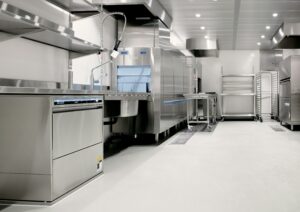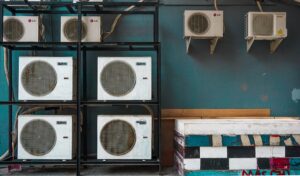A functioning refrigerator is an essential appliance in any household. It keeps our food fresh, prevents spoilage, and ensures that we have access to safe and healthy meals. However, like any other appliance, refrigerators can experience issues that affect their performance. From strange noises to leaks and cooling problems, these issues can be frustrating and inconvenient. In this blog post, we will explore some of the most common problems that can occur with refrigerators and provide possible solutions for each issue.
Key Takeaways
- Strange noises from your refrigerator can indicate a variety of issues, including a faulty fan or compressor.
- A refrigerator not cooling can be caused by a variety of factors, such as a dirty condenser coil or a malfunctioning thermostat.
- Leaking refrigerators can be caused by a clogged drain or a damaged water inlet valve.
- A freezer not freezing can be caused by a faulty evaporator fan or a malfunctioning defrost thermostat.
- Fridge door seal issues can be detected by checking for air leaks and can be fixed by cleaning or replacing the seal.
Strange Noises Coming from Your Refrigerator: What They Mean
One of the first signs that something may be wrong with your refrigerator is the presence of strange noises. These noises can range from a buzzing or humming sound to a loud banging or rattling noise. Understanding what these noises mean is crucial in addressing any potential issues.
A buzzing or humming sound could indicate a problem with the compressor or the condenser fan motor. The compressor is responsible for circulating refrigerant throughout the system, while the condenser fan motor helps dissipate heat from the refrigerator. If either of these components is malfunctioning, it can result in unusual noises.
On the other hand, a loud banging or rattling noise could be a sign of loose or worn-out parts within the refrigerator. This could include loose screws, a faulty motor, or a worn-out fan blade. Ignoring these noises can lead to further damage and potentially costly repairs.
Refrigerator Not Cooling: Causes and Solutions
One of the most common issues that homeowners face with their refrigerators is when it stops cooling properly. This can lead to food spoilage and potential health risks if not addressed promptly. There are several possible causes for a refrigerator not cooling properly, and each has its own solution.
One common cause is a dirty condenser coil. Over time, dust and debris can accumulate on the condenser coil, preventing it from dissipating heat effectively. Cleaning the condenser coil regularly can help improve the cooling performance of the refrigerator.
Another possible cause is a malfunctioning thermostat. The thermostat is responsible for regulating the temperature inside the refrigerator. If it is not functioning correctly, it may not be sending the proper signals to the cooling system. Replacing a faulty thermostat can help restore proper cooling.
Additionally, a malfunctioning evaporator fan motor can also lead to cooling issues. The evaporator fan motor circulates cold air throughout the refrigerator, and if it is not working properly, the refrigerator may not cool evenly. Replacing the fan motor can resolve this issue.
Leaking Refrigerator: Troubleshooting Tips
A leaking refrigerator can be a frustrating problem to deal with. Not only does it create a mess, but it can also indicate an underlying issue that needs to be addressed. There are several possible causes for a leaking refrigerator, and troubleshooting tips can help identify and fix the issue.
One common cause of a leaking refrigerator is a clogged or frozen defrost drain. The defrost drain is responsible for removing excess water from the freezer during the defrost cycle. If it becomes clogged or frozen, water can accumulate and leak out of the refrigerator. Clearing the defrost drain with hot water or a pipe cleaner can resolve this issue.
Another possible cause is a faulty water inlet valve. The water inlet valve controls the flow of water into the refrigerator for ice makers and water dispensers. If it is not functioning correctly, it can lead to leaks. Replacing the water inlet valve can solve this problem.
Additionally, a damaged or misaligned door gasket can also cause leaks. The door gasket creates a seal between the refrigerator door and the cabinet, preventing warm air from entering and cold air from escaping. If it is damaged or misaligned, water can leak out. Replacing or realigning the door gasket can fix this issue.
Freezer Not Freezing: Common Causes and Fixes
A freezer that is not freezing properly can be a major inconvenience, as it can lead to food spoilage and waste. There are several common causes for a freezer not freezing, and each has its own potential solution.
One possible cause is a malfunctioning thermostat. The thermostat regulates the temperature inside the freezer, and if it is not functioning correctly, it may not be sending the proper signals to the cooling system. Replacing a faulty thermostat can help restore proper freezing.
Another common cause is a dirty condenser coil. As mentioned earlier, dust and debris can accumulate on the condenser coil over time, preventing it from dissipating heat effectively. Cleaning the condenser coil regularly can help improve the freezing performance of the freezer.
Additionally, a malfunctioning evaporator fan motor can also lead to freezing issues. The evaporator fan motor circulates cold air throughout the freezer, and if it is not working properly, the freezer may not freeze evenly. Replacing the fan motor can resolve this issue.
Fridge Door Seal Issues: How to Detect and Fix Them

The door seal, also known as the gasket, plays a crucial role in maintaining the efficiency of a refrigerator. It creates an airtight seal between the refrigerator door and the cabinet, preventing warm air from entering and cold air from escaping. If there are issues with the door seal, it can lead to energy loss and temperature fluctuations inside the refrigerator.
Detecting a faulty door seal is relatively easy. One common method is to place a dollar bill between the door gasket and the cabinet and close the door. If you can easily pull out the dollar bill without any resistance, it indicates that there is an issue with the door seal.
There are several possible solutions for fixing a faulty door seal. One option is to clean the gasket with warm soapy water and a soft cloth to remove any dirt or debris that may be preventing a proper seal. If the gasket is damaged or worn out, it may need to be replaced. Replacement gaskets can be purchased from appliance stores or online.
Ice Maker Not Working: Possible Reasons and Solutions
An ice maker that is not working can be a frustrating problem, especially during the hot summer months when ice is in high demand. There are several common causes for an ice maker not working, and each has its own potential solution.
One possible cause is a clogged water line. Over time, minerals and debris can accumulate in the water line, preventing water from flowing freely to the ice maker. Flushing the water line with hot water or using a pipe cleaner can help remove any clogs and restore proper water flow.
Another common cause is a faulty water inlet valve. The water inlet valve controls the flow of water into the ice maker, and if it is not functioning correctly, it may not be supplying water to the ice maker. Replacing the water inlet valve can solve this problem.
Additionally, a malfunctioning ice maker motor or thermostat can also lead to ice maker issues. If either of these components is not working properly, it may not be producing ice. Replacing the motor or thermostat can resolve this issue.
Fridge Light Not Working: How to Troubleshoot and Repair
A fridge light that is not working may seem like a minor issue, but it can be inconvenient when trying to find items in a dark refrigerator. There are several possible causes for a fridge light not working, and troubleshooting tips can help identify and fix the issue.
One common cause is a burnt-out light bulb. Simply replacing the light bulb with a new one can solve this problem. It is important to ensure that the new light bulb has the correct wattage and size for your refrigerator.
Another possible cause is a faulty door switch. The door switch is responsible for turning the light on and off when the refrigerator door is opened and closed. If it is not functioning correctly, it may not be sending the proper signals to the light bulb. Replacing the door switch can resolve this issue.
Additionally, a loose or damaged wiring connection can also cause the fridge light to stop working. Checking the wiring connections and repairing any loose or damaged wires can fix this problem.
Refrigerator Overcooling: Symptoms and How to Fix It
While a refrigerator that is not cooling enough can be a problem, an overcooling refrigerator can also be an issue. Symptoms of an overcooling refrigerator include frozen food, excessive frost buildup, and condensation inside the refrigerator. There are several possible solutions for fixing an overcooling refrigerator.
One possible cause is a faulty temperature control thermostat. The temperature control thermostat regulates the temperature inside the refrigerator, and if it is not functioning correctly, it may be causing the refrigerator to overcool. Replacing the thermostat can help resolve this issue.
Another common cause is a malfunctioning defrost timer or control board. The defrost timer or control board controls the defrost cycle in the refrigerator, and if it is not working properly, it may be causing excessive cooling. Replacing the defrost timer or control board can solve this problem.
Additionally, a malfunctioning damper control assembly can also lead to overcooling. The damper control assembly regulates the flow of cold air from the freezer to the refrigerator. If it is not functioning correctly, it may be allowing too much cold air into the refrigerator. Replacing the damper control assembly can fix this issue.
Condensation in Your Fridge: What Causes It and How to Stop It
Condensation in a refrigerator can be a frustrating problem, as it can lead to mold growth, food spoilage, and unpleasant odors. There are several possible causes of condensation in a refrigerator, and there are ways to stop it.
One common cause is a faulty door seal. As mentioned earlier, the door seal creates an airtight seal between the refrigerator door and the cabinet. If it is damaged or misaligned, warm air can enter the refrigerator, leading to condensation. Replacing or realigning the door seal can help prevent condensation.
Another possible cause is a blocked drain tube. The drain tube is responsible for removing excess water from the defrost cycle. If it becomes blocked, water can accumulate and lead to condensation. Clearing the drain tube with hot water or a pipe cleaner can resolve this issue.
Additionally, opening the refrigerator door frequently or for extended periods can also contribute to condensation. Each time the door is opened, warm air enters the refrigerator, which can lead to condensation. Minimizing the frequency and duration of door openings can help reduce condensation.
Refrigerator Electrical Problems: How to Identify and Solve Them
Electrical problems in a refrigerator can be challenging to diagnose and fix. However, there are common electrical issues that homeowners may encounter, along with troubleshooting tips for identifying and solving them.
One common electrical problem is a tripped circuit breaker or blown fuse. If the refrigerator suddenly stops working, checking the circuit breaker or fuse box is a good first step. Resetting a tripped circuit breaker or replacing a blown fuse can restore power to the refrigerator.
Another possible electrical issue is a faulty power cord or plug. Over time, the power cord or plug may become damaged or worn out, preventing proper electrical connection. Inspecting the power cord and plug for any signs of damage and replacing them if necessary can solve this problem.
Additionally, a malfunctioning start relay or overload protector can also cause electrical problems in a refrigerator. These components are responsible for starting and protecting the compressor. If they are not functioning correctly, it may result in power issues. Replacing the start relay or overload protector can resolve this issue.
A functioning refrigerator is essential for keeping our food fresh and safe to consume. Addressing any issues promptly is crucial in maintaining the performance and efficiency of the appliance. From strange noises to cooling problems, leaks, and electrical issues, there are various problems that can occur with refrigerators. By understanding the common causes and possible solutions for each issue, homeowners can troubleshoot and fix these problems themselves or seek professional help when needed. Regular maintenance and care can also help prevent these issues from occurring in the first place, ensuring that your refrigerator continues to serve you well for years to come.
If you’re experiencing issues with your refrigerator, it’s important to understand the symptoms and signs that could indicate a problem. In our article on Decoding Common Refrigerator Problems: Symptoms and Signs, we provide valuable insights into identifying and troubleshooting common issues. For more information on how to keep your appliances running smoothly, check out our related article on Appliance Repair Services.
How Can I Identify Common Refrigerator Problems Based on Symptoms and Signs?
When it comes to systematic diagnosing refrigerators, it’s important to pay attention to common signs of problems such as inconsistent cooling, strange noises, and excessive frost buildup. Any of these symptoms could indicate issues with the compressor, thermostat, or other vital components.



